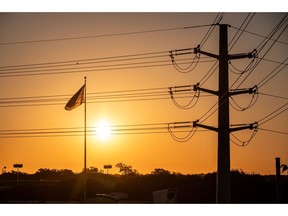
Article content
(Bloomberg) — With temperatures set to exceed 100F this week, electricity grids in New York City and other areas along the US east coast are experiencing stress, triggering a blackout in the city on Monday and emergency alerts elsewhere. It’s a pattern that will likely be more common across the country over the coming months, but experts say there are changes consumers can make to help prevent power outages.
THIS CONTENT IS RESERVED FOR SUBSCRIBERS ONLY
Subscribe now to read the latest news in your city and across Canada.
- Exclusive articles from Barbara Shecter, Joe O'Connor, Gabriel Friedman, and others.
- Daily content from Financial Times, the world's leading global business publication.
- Unlimited online access to read articles from Financial Post, National Post and 15 news sites across Canada with one account.
- National Post ePaper, an electronic replica of the print edition to view on any device, share and comment on.
- Daily puzzles, including the New York Times Crossword.
SUBSCRIBE TO UNLOCK MORE ARTICLES
Subscribe now to read the latest news in your city and across Canada.
- Exclusive articles from Barbara Shecter, Joe O'Connor, Gabriel Friedman and others.
- Daily content from Financial Times, the world's leading global business publication.
- Unlimited online access to read articles from Financial Post, National Post and 15 news sites across Canada with one account.
- National Post ePaper, an electronic replica of the print edition to view on any device, share and comment on.
- Daily puzzles, including the New York Times Crossword.
REGISTER / SIGN IN TO UNLOCK MORE ARTICLES
Create an account or sign in to continue with your reading experience.
- Access articles from across Canada with one account.
- Share your thoughts and join the conversation in the comments.
- Enjoy additional articles per month.
- Get email updates from your favourite authors.
THIS ARTICLE IS FREE TO READ REGISTER TO UNLOCK.
Create an account or sign in to continue with your reading experience.
- Access articles from across Canada with one account
- Share your thoughts and join the conversation in the comments
- Enjoy additional articles per month
- Get email updates from your favourite authors
Sign In or Create an Account
or
Article content
Article content
“Extreme weather events of all kinds – heat waves, hurricanes, flooding events – are putting immense stress on the grid and on people’s lives,” says Kit Kennedy, who leads the power division at non-profit Natural Resources Defense Council. Simple actions by consumers, such as avoiding charging your electric car during peak hours and raising air conditioning’s temperature, can ease grid stress, Kennedy says. “Flexibility is going to be the key.”
Article content
Article content
By signing up you consent to receive the above newsletter from Postmedia Network Inc.
Article content
On Monday, Consolidated Edison Inc., the utility serving New York City, appealed to homes and businesses to conserve electricity in parts of Queens, Brooklyn and Staten Island as heat strained equipment and air conditioning usage soared. The state grid operator also called on consumers to use less power to help avoid an outright grid emergency on Tuesday as well.
Article content
The US is heading into a hotter-than-usual summer, and utilities across the nation have warned this could lead to power shortages. Here’s what you need to know about how extreme heat affects grids and how you can help prevent blackouts.How Extreme Heat Hurts Power GridsIn a way, the grid functions like a seesaw: it stays stable if the power supply and demand are equal. But periods of high heat can throttle the efficiency of power generation and transmission, impairing the supply. Meanwhile, more homes, offices, shops and factories will turn on electric fans or ACs, sucking more juice out of the grid. When the demand and supply fall out of balance, a power outage can occur, says Timothy Wang, a managing director at consulting firm Filsinger Energy Partners.Sweltering weather can also cause transmission lines to sag. That happened in 2003, causing the Northeast Blackout, which left more than 50 million Americans and Canadians in the dark.
Article content
Article content
The transformers needed to keep electricity flowing can also heat up, limiting their ability to handle rising power needs. Elevated overnight temperatures means equipment can’t cool when the sun sets. If the power load on the grid goes up too high, an aging transformer could blow up, likely causing a power outrage or worse, a fire, Wang says.
Article content
What Does a Heat-Stressed Grid Mean for Consumers? “A catastrophic grid failure is a safety issue,” says Bob Marshall, chief executive officer of Whisker Labs, a company that develops smart sensors to monitor power quality in homes. If there’s a prolonged power outage, what happens to patients who rely on life support systems?
Article content
The consumers who are lucky enough to keep the lights on may end up paying more for their electricity. Wholesale electricity costs can spike in extreme weather. These prices are passed on to consumers on their monthly bills, but by how much and how quickly will vary.
Article content
Extreme heat also distorts the normal flow of electricity on transmission lines, causing the electronic appliances in your home to use more power, Marshall says. That’s because electricity travels across high-voltage lines in waves, and when those wave patterns deviate from what’s considered ideal, it distorts the power that flows into homes. That can add as much as 20% more on consumers’ electricity bills, according to an estimate by Whisker Labs.

.jpg) 5 hours ago
3
5 hours ago
3
 English (US)
English (US)